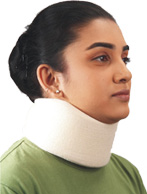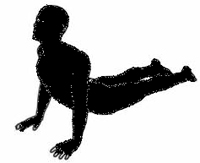Introduction

Symptoms of cervical spondylolysis can be caused by either the spinal cord compression or nerve root damage. They stem from the mechanical instability of the spinal segment that is affected by the disorder. If the spinal cord is compressed often a patient may notice a change in the way they walk. Leg movements may be jerky and walking can become unsteady. A patient may suffer from some general neck pain because of nerve root damage. There may also be some weakness and loss of muscle strength in one or both arms that may develop either before or after signs of spinal cord compression. Often different yoga asanas are helpful in stabilizing or improving the problems caused by cervical spondylolysis.
Yoga and Cervical Spondylolysis
Yoga as a preventive medicine is being used widely around the world. People in there thousands are taking up this ancient practice which is said to prevent and treat a range of diseases including Cervical spondylolysis, Arterial Hypertension, Headaches, Mental disorders while having the benefit of lowering blood pressure and reducing hip joint pain. Yoga practise has increased dramatically in the west since the early 1900's, when many Indian yoga masters began to travel to the USA, Germany and many other countries. , attracting attention and followers. Hatha Yoga was the most popular Yoga form in the west. Slowly and gradually Yoga came to assume importance in matters related to health, peace, fitness and spirituality.YOGA POSES FOR CERVICAL SPONDYLOLYSIS
Child Pose
The Child�s Pose is a beginner yoga pose that stretches the muscles of the low back, as well as the inner thighs. For those with tight back and hip muscles, this will, of course, feel like work. But get beyond the tension and Child�s Pose is deeply relaxing. It promotes flexibility, stress relief and helps circulation to the muscles, joints and disks of the back.Cobra Pose
This Yoga Pose improves spinal flexibility and strengthens the muscles in the arms and back. In addition, it is effective in relieving menstrual irregularities and constipation.Fish Pose
Traditionally Fish Pose is performed with the legs in Padmasana. Since Padmasana is beyond the capacity of most beginning students, here we�ll work either with the knees bent, feet on the floor or with the legs straight pressed against the floor.Camel Pose
Compresses the spine helping to ease back & neck problems, opens the rib cage, heart, lungs & digestive system, stimulates the nervous system, great for lungs & any problem in the bronchial plexus (a bundle of 5 nerves, which control muscles in the shoulder, arm & hand), strengthens back & shoulder muscles, improves neck movement, stretches the throat, sends fresh blood to kidneys & helps to eliminate toxins.Balancing Stick Pose
Helps improve blood flow to the whole body especially the heart & lungs, helps to clear/prevent blocked arteries /future cardiac problems, total spine stretch, relieves stress from spine, great for mental health, helps prevent & heal varicose veins, builds strength in the lower body & exercises the pancreas, liver, spleen, the nervous system & circulatory system.YOGA ASANAS FOR CERVICAL SPONDYLOLYSIS
MATSYASANA
The Sanskrit word matsya means fish, therefore this is the fish posture. Matsya (depicted to the left) is a divine being, found in Hindu mythology that saved mankind from a universal flood. The matsya-asana creates a great expansion and stretching of the chest which helps relieve upper respiratory congestion as well as benefits the heart. Additionally, the sinus are drained and opened from the inversion of the head, stretching of the neck and pressure placed on the top of the head.
Steps
- Lie on your back on the floor with your knees bent, feet on the floor. Inhale, lift your pelvis slightly off the floor, and slide your hands, palms down, below your buttocks. Then rest your buttocks on the backs of your hands (and don�t lift them off your hands as you perform this pose). Be sure to tuck your forearms and elbows up close to the sides of your torso.
- Inhale and press your forearms and elbows firmly against the floor. Next press your scapulas into your back and, with an inhale, lift your upper torso and head away from the floor. Then release your head back onto the floor. Depending on how high you arch your back and lift your chest, either the back of your head or its crown will rest on the floor. There should be a minimal amount of weight on your head to avoid crunching your neck.
- You can keep your knees bent or straighten your legs out onto the floor. If you do the latter, keep your thighs active, and press out through the heels.
- Stay for 15 to 30 seconds, breathing smoothly. With an exhalation lower your torso and head to the floor. Draw your thighs up into your belly and squeeze.
BHUJANGASANA

Steps
- Lie in the prone position with the forehead resting on the floor, legs straight and feet together, toes pointing backwards, arms bent at the elbows, palms flat on the floor, shoulders and arms on the sides of the chest and fingers kept straight And together.
- Inhale slowly and the raise the upper body (head, neck and chest). Look at the ceiling (sky) with the neck bent as far back as possible. For raising the body, only the back muscles are to be used.
- Do not push up with your arms. Waist, legs and toes should remain on the ground. Raise your body as much as possible, holding the position and retaining the breath for a few seconds.
- Exhaling slowly, return to the original position. Repeat three to four times.
TULADANDASANA

Steps
- Stand with your feet together.
- Stretch your arms up over your head and interlock the fingers, index fingers pointing up to form your steeple. The arms are right behind your ears.
- Stretch your upper body backward, so that the chest puffs up and forward.
- Now take a big step to the front with your right leg. Come up on the toes of your back foot. Look forward into the mirror.
- Now, with your body one solid piece from the fingers to your toes, knees and elbows locked, pivot directly forward on your hip joint while simultaneously raising your left leg behind you, toes pointed. Again, your abdomen should be exactly parallel to the floor as are your outstretched arms and extended back leg: one straight line. Both knees are locked.
Diseases Related to Taurus |
||


